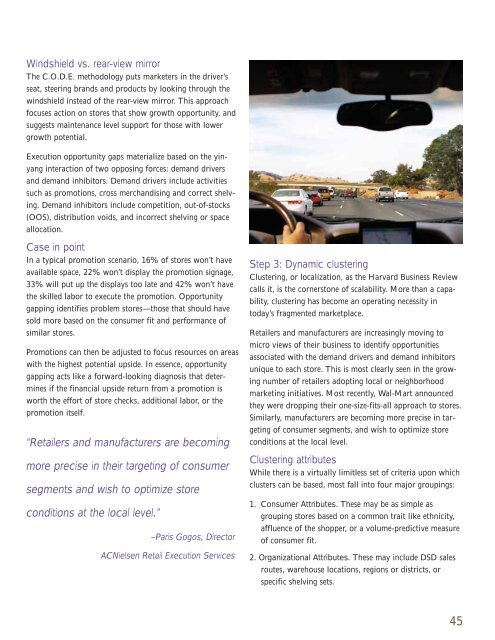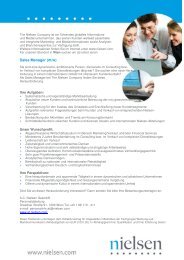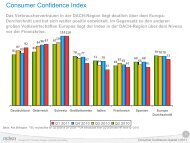Create successful ePaper yourself
Turn your PDF publications into a flip-book with our unique Google optimized e-Paper software.
Windshield vs. rear-view mirror<br />
The C.O.D.E. methodology puts marketers in the driver’s<br />
seat, steering brands and products by looking through the<br />
windshield instead of the rear-view mirror. This approach<br />
focuses action on stores that show growth opportunity, and<br />
suggests maintenance level support for those with lower<br />
growth potential.<br />
Execution opportunity gaps materialize based on the yinyang<br />
interaction of two opposing forces: demand drivers<br />
and demand inhibitors. Demand drivers include activities<br />
such as promotions, cross merchandising and correct shelving.<br />
Demand inhibitors include competition, out-of-stocks<br />
(OOS), distribution voids, and incorrect shelving or space<br />
allocation.<br />
Case in point<br />
In a typical promotion scenario, 16% of stores won’t have<br />
available space, 22% won’t display the promotion signage,<br />
33% will put up the displays too late and 42% won’t have<br />
the skilled labor to execute the promotion. Opportunity<br />
gapping identifies problem stores—those that should have<br />
sold more based on the consumer fit and performance of<br />
similar stores.<br />
Promotions can then be adjusted to focus resources on areas<br />
with the highest potential upside. In essence, opportunity<br />
gapping acts like a forward-looking diagnosis that determines<br />
if the financial upside return from a promotion is<br />
worth the effort of store checks, additional labor, or the<br />
promotion itself.<br />
“Retailers and manufacturers are becoming<br />
more precise in their targeting of consumer<br />
segments and wish to optimize store<br />
conditions at the local level.”<br />
–Paris Gogos, Director<br />
ACNielsen Retail Execution Services<br />
Step 3: Dynamic clustering<br />
Clustering, or localization, as the Harvard Business Review<br />
calls it, is the cornerstone of scalability. More than a capability,<br />
clustering has become an operating necessity in<br />
today’s fragmented marketplace.<br />
Retailers and manufacturers are increasingly moving to<br />
micro views of their business to identify opportunities<br />
associated with the demand drivers and demand inhibitors<br />
unique to each store. This is most clearly seen in the growing<br />
number of retailers adopting local or neighborhood<br />
marketing initiatives. Most recently, Wal-Mart announced<br />
they were dropping their one-size-fits-all approach to stores.<br />
Similarly, manufacturers are becoming more precise in targeting<br />
of consumer segments, and wish to optimize store<br />
conditions at the local level.<br />
Clustering attributes<br />
While there is a virtually limitless set of criteria upon which<br />
clusters can be based, most fall into four major groupings:<br />
1. Consumer Attributes. These may be as simple as<br />
grouping stores based on a common trait like ethnicity,<br />
affluence of the shopper, or a volume-predictive measure<br />
of consumer fit.<br />
2. Organizational Attributes. These may include DSD sales<br />
routes, warehouse locations, regions or districts, or<br />
specific shelving sets.<br />
45











